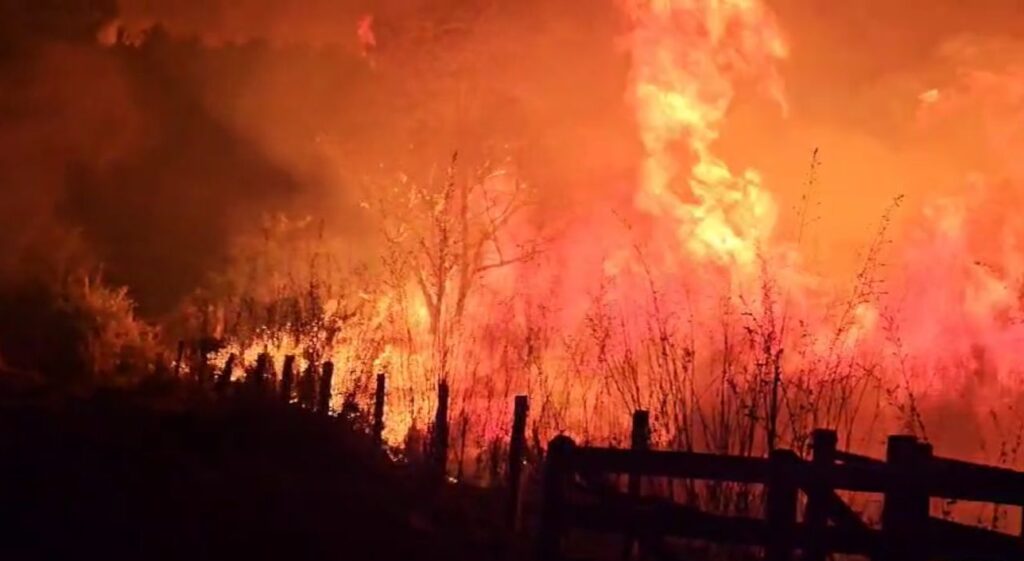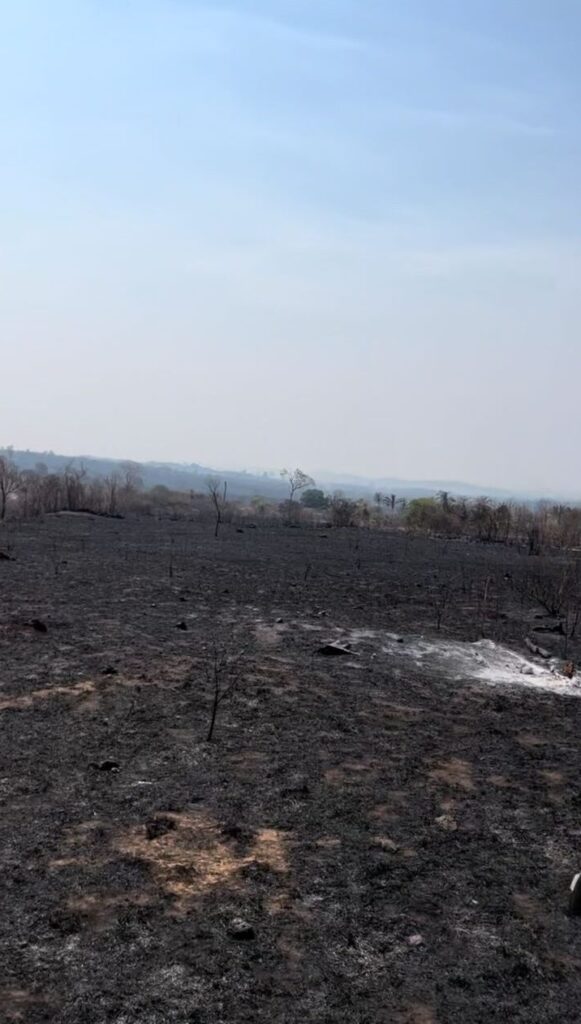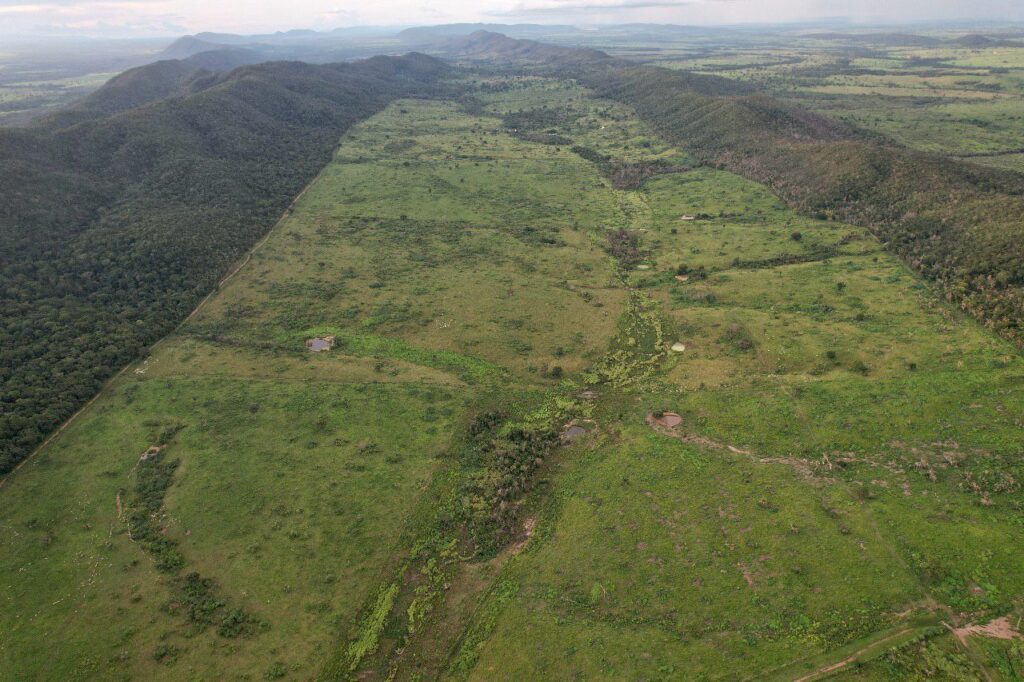Em setembro do ano passado, nossa maior propriedade rural no Brasil foi atingida por um incêndio devastador. O mesmo fogo consumiu uma área do tamanho da Itália, entre o Cerrado e a Amazônia. Nossa propriedade de 13.000 hectares, dedicada à pecuária, cultivo de grãos e agroflorestamento, está localizada no município de Pontes e Lacerda, próximo à fronteira com a Bolívia. O fogo teve origem em uma propriedade vizinha e se alastrou rapidamente para nossas pastagens e áreas de reserva florestal. Graças ao vento favorável, nossas instalações e infraestrutura principal não foram atingidas, e não houve feridos entre os funcionários ou animais. No entanto, acordar em Amsterdã e ver vídeos do fogo devastando a terra que estávamos cuidadosamente regenerando foi de partir o coração. Diferentemente dos incêndios catastróficos que atingem mansões na Califórnia, quando o fogo afeta florestas preciosas no Brasil, não há aviões de combate a incêndios para combater as chamas.


Nossa equipe teve que se virar com o que podia, usando os recursos disponíveis na vizinhança, como homens e equipamentos agrícolas. Lembrem-se de que estamos falando de milhares de hectares, então as propriedades vizinhas são distantes umas das outras, com acesso limitado por estrada, e quando o fogo chegou, elas também foram consumidas pelas chamas. Com um sentimento de completa impotência, tudo o que eu podia fazer era assistir anos de trabalho virarem cinzas em questão de horas. A seca severa, que já afetava duramente o fluxo de caixa da nossa fazenda, ainda nos daria mais um golpe. O fogo devastou a região por alguns dias, até que conseguíssemos reagrupar os animais e avaliar os danos. Tudo aconteceu na primeira semana de setembro, e os danos incluíram quilômetros de cercas e hectares de pastagens, mas sabíamos pouco sobre a extensão dos danos nas áreas de floresta nativa. Os primeiros relatos que recebemos mencionavam que as primeiras áreas de restauração florestal provavelmente haviam sido perdidas. Nossa fazenda de pesquisa e desenvolvimento, com 1.200 hectares, a poucos quilômetros de distância, foi poupada do fogo, então a esperança de um novo começo era o único consolo ao qual eu podia me agarrar. Continuamos firmes com a ajuda da dedicada equipe da fazenda, que encontrou alternativas para manter todos os animais o mais saudáveis possível. Também tomamos a difícil decisão de prosseguir com os projetos de restauração planejados para o início da estação chuvosa, plantando mais 28 hectares de floresta em dezembro.

Menos de cinco meses depois, eu estava de volta à fazenda com todos os meus sócios para nossa reunião de diretoria no local. Eu havia pedido à equipe que nos levasse para conhecer as áreas devastadas para que pudéssemos ter uma ideia mais clara de como elas estavam reagindo com o início da estação chuvosa, que este ano chegou com força total, despejando chuvas torrenciais muito necessárias no Cerrado brasileiro. O que vi foi a lição mais impressionante sobre o poder da natureza e a resiliência do bioma Cerrado que já presenciei. A fazenda estava verdejante, com a maior parte da floresta se regenerando e os campos prosperando novamente. Era preciso olhar atentamente entre as copas das árvores para ainda ver os danos causados pelo fogo, mas a natureza mostrava todos os sinais de que estava em pleno processo de regeneração. O mais impressionante foram as áreas que havíamos plantado no início do projeto. A equipe considerava aqueles terrenos uma tentativa fracassada de plantar espécies nativas de árvores. Naquela época, quando fizemos as primeiras tentativas de restauração, a equipe ainda não tinha o conhecimento e as habilidades necessárias para realizar restaurações eficazes. Além disso, a área não recebia a devida manutenção, e o incêndio foi visto como a gota d'água, mas o que aconteceu foi o contrário. A área se recuperou ainda mais forte. Árvores jovens sobreviveram ao fogo e sementes dormentes começaram a germinar com as fortes chuvas. A área está quase como uma floresta nativa novamente.


As novas áreas que a equipe plantou em dezembro também estão prosperando, e quanto mais plantam, melhor e mais eficientes se tornam na restauração de grandes áreas, utilizando uma combinação da técnica indígena de “muvuca” — uma bomba de sementes nativas plantada diretamente no solo com composto — combinada com sementes de espécies que usamos como cobertura vegetal para fornecer proteção inicial ao solo e mudas de espécies nativas mais sensíveis às condições do solo e ao clima. Além de aprimorar a restauração, a equipe também descobriu novos benefícios indiretos de trabalhar em parceria com a natureza. A predação da soja por javalis ou pela raça mista chamada “Java Porco” (um cruzamento entre javali e porco doméstico) é um dos principais problemas enfrentados pelos produtores de soja. O que aprendemos na prática em nossos campos é que as áreas recém-restauradas, plantadas próximas às reservas naturais existentes, forneceram uma zona de alimentação para os animais selvagens, que apreciaram a variedade de grãos silvestres presentes em nossa mistura de cobertura vegetal muito mais do que a soja comum que exportamos para a Europa para pagar nossas contas. Os javalis também ajudam a fertilizar as novas áreas e a espalhar mais sementes.

A beleza da agricultura regenerativa reside no fato de que, ao deixarmos de lutar contra a natureza com um monte de produtos químicos caros e começarmos a trabalhar em parceria com a ecologia local, surge um fluxo quase mágico, unindo as peças num vórtice positivo que pode gerar benefícios inesperados. Devemos também levar em consideração que o bioma Cerrado é naturalmente resiliente ao fogo, ao contrário do bioma Amazônico, infelizmente. Contudo, a natureza está demonstrando uma força e resiliência incríveis neste momento de crise climática, dando-nos a esperança necessária para arregaçarmos as mangas e fazermos o que estiver ao nosso alcance para apoiar essa regeneração.

